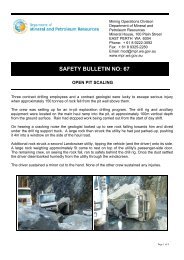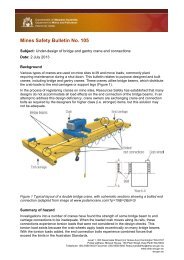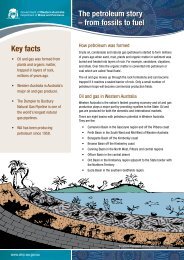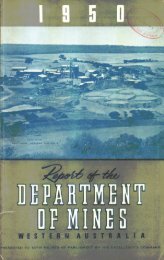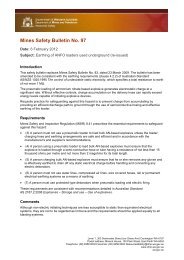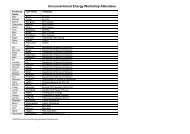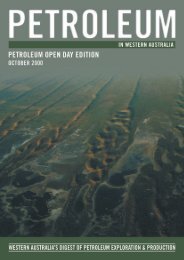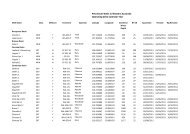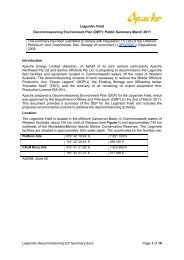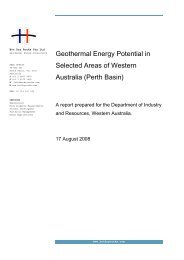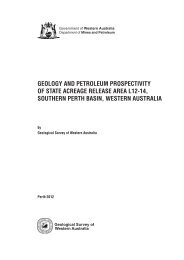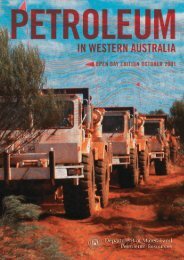Phase III - Department of Mines and Petroleum
Phase III - Department of Mines and Petroleum
Phase III - Department of Mines and Petroleum
You also want an ePaper? Increase the reach of your titles
YUMPU automatically turns print PDFs into web optimized ePapers that Google loves.
The GJV have focussed their priorities on the detection <strong>of</strong> early failure modes in the deep subsurface (in<br />
<strong>and</strong> around the target reservoir). This is a sensible approach <strong>and</strong> to some extent, depending on the efficacy<br />
<strong>of</strong> the deep monitoring tools, reduces the requirement for exhaustive shallow or surface monitoring<br />
deployments.<br />
More specifically, the monitoring strategy is guided by the requirements <strong>of</strong> the Uncertainty Management<br />
Plan. Provided this is valid, <strong>and</strong> the highside/lowside outcomes are properly taken into account, then the<br />
overall monitoring plan is largely robust. The major containment risks appear to have been satisfactorily<br />
identified <strong>and</strong> the strategy <strong>of</strong> time-lapse 3D/2D surface seismic, observation wells <strong>and</strong> soil gas<br />
measurements is, in principle, well suited to deal with these risks.<br />
Figure 12 Output from the International Energy Association Greenhouse Gas R&D Programme (IEAGHG) monitoring<br />
selection tool for a simplified Barrow Isl<strong>and</strong> (onshore) scenario with ‘basic’ filter. The tools that would normally be<br />
considered essential are highlighted in red.<br />
Time-lapse surface seismic is identified as the key monitoring tool. Its capability is, however, constrained<br />
by the very variable seismic data quality so far obtained across Barrow Isl<strong>and</strong> <strong>and</strong> the stringent l<strong>and</strong>-use<br />
restrictions imposed on surface activities. A major project risk therefore is the significant possibility that<br />
3D surface seismic may not be able to satisfactorily image the CO 2 plume everywhere. The GJV have<br />
evaluated the main seismic quality parameters <strong>and</strong> a limited seismic pilot study has been carried out to<br />
further optimise the baseline 3D survey <strong>and</strong> assess repeatability. This is commendable but spatial coverage<br />
<strong>of</strong> such a test is limited. It is recommended that the report on the seismic pilot study <strong>and</strong> final specification<br />
for the 3D seismic survey be reviewed in the <strong>Phase</strong> IV assessment.<br />
The GJV has followed a thorough process in identifying the most suitable technologies <strong>and</strong> completion<br />
geometries for monitoring saturation <strong>and</strong> pressure changes in both CO 2 injection wells <strong>and</strong> observation<br />
(surveillance) wells. Clear, well defined objectives for each monitoring variable (pressure, temperature,<br />
saturation, fluid sampling, etc.) have been documented. These objectives have been reflected in the<br />
Uncertainty Management Plan with initial “signposts” or indicators <strong>of</strong> lowside <strong>and</strong> highside project<br />
outcomes identified. These signposts are based on early simulation results <strong>and</strong> will need to be revisited in<br />
light <strong>of</strong> the most recent project study findings (i.e., dynamic simulation model, geomechanics, geochemical<br />
<strong>and</strong> injectivity reports) to ensure they remain reasonable indicators for the implementation <strong>of</strong> mitigation<br />
plans. The monitoring <strong>of</strong> saturation <strong>and</strong> pressure changes in the observation <strong>and</strong> injection wells will help<br />
calibrate the seismic data <strong>and</strong> the integration <strong>of</strong> the seismic <strong>and</strong> well logging datasets will clearly be<br />
beneficial.<br />
xxxv



